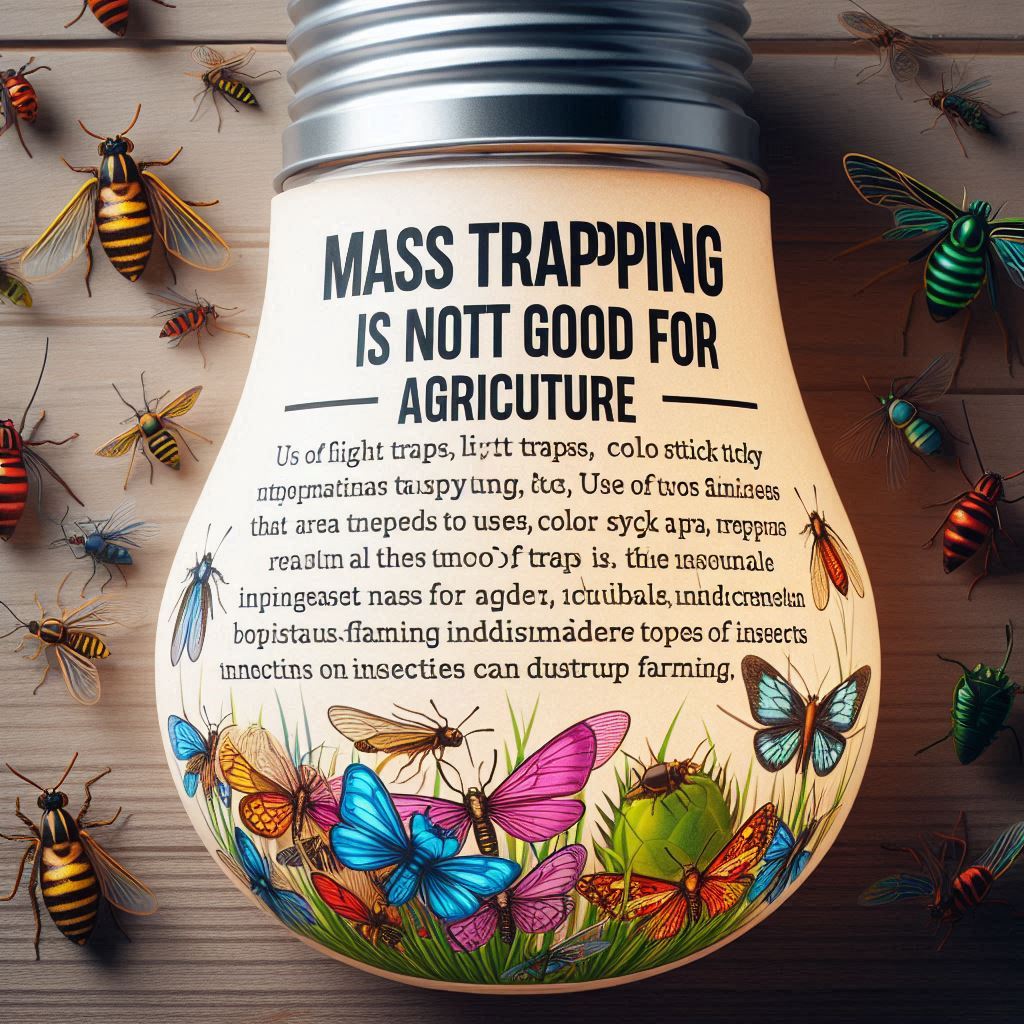
Agriculture has always battled insect pests, and farmers often look for convenient ways to manage them. Mass trapping techniques like light traps, solar light traps, sticky traps, and other large-scale trapping methods may seem effective at first glance, but they come with serious unintended consequences. While these methods capture large numbers of insects, they do not differentiate between harmful pests and beneficial insects. This indiscriminate trapping can severely disrupt the farm ecosystem, leading to long-term negative effects. Let’s explore why mass trapping is problematic and why targeted approaches like pheromone traps should be preferred.
Light traps attract insects using artificial light sources. Farmers get a sense of satisfaction seeing heaps of insects caught overnight, assuming they are effectively controlling pests. However, research and field observations show that light traps capture a wide variety of insects—both harmful and beneficial. Beneficial predators like ladybugs, lacewings, and parasitic wasps, which naturally control pest populations, are often caught in large numbers. This disrupts the natural balance and can actually make pest problems worse in the long run.
Solar light traps have further enhanced the convenience of this method. These traps are energy-efficient, requiring no external power source, and can operate automatically. While they are an improvement in terms of cost-effectiveness and sustainability, they still pose the same ecological risks as traditional light traps. They attract a mix of pests and beneficial insects indiscriminately, leading to biodiversity loss and ecological imbalances.
Sticky traps are an improvement over light traps as they are more localized and can be color-coded to target specific insect groups. For example, yellow sticky traps are used to attract aphids and whiteflies. However, like light traps, they still capture indiscriminately. Small beneficial insects, including pollinators and natural enemies of pests, can also get trapped. Overuse of sticky traps in an area can lead to unintended ecological damage.
Apart from light and sticky traps, other mass trapping methods are also used in agriculture:
Bait Traps: These use food-based or chemical baits to attract insects. While they can be effective against certain pests, they may also lure non-target species, leading to unintended consequences.
Water Traps: These involve using a water-filled container with an attractant to drown insects. However, beneficial insects such as bees and predatory beetles can also fall victim to these traps.
Mechanical Suction Traps: These devices use airflow to capture insects. While effective in reducing pest populations, they also pose a risk to beneficial species and require constant maintenance.
Unlike mass trapping methods, pheromone traps are highly targeted. These traps use species-specific pheromones to lure only the intended pest, such as fruit borers or moths, leaving beneficial insects unharmed. This precision makes them a far more sustainable option for pest management.
Why Pheromone Traps Are a Smarter Choice
Unlike mass trapping methods, pheromone traps are highly targeted. These traps use species-specific pheromones to lure only the intended pest, such as fruit borers or moths, leaving beneficial insects unharmed. This precision makes them a far more sustainable option for pest management.
Pheromone traps can serve multiple purposes:
Monitoring Pest Populations: Farmers can assess pest pressure and make informed decisions about control methods.
Mass Trapping of Specific Pests: When used correctly, these traps can reduce pest populations significantly without affecting beneficial insects.
Integrating with Other Methods: Pheromone traps fit well within Integrated Pest Management (IPM) strategies, reducing reliance on chemical pesticides.
While farmers naturally seek visible and immediate results, it is crucial to consider the broader ecological impact of pest control methods. Mass trapping with indiscriminate tools like light traps (including solar light traps), sticky traps, and other non-selective methods can do more harm than good, disrupting natural predation cycles and harming pollinators. Instead, targeted approaches like pheromone traps should be encouraged for sustainable pest management.
By choosing intelligent, ecosystem-friendly pest control strategies, farmers can maintain a healthy balance in their fields, ensuring better long-term productivity and sustainability.
There was this interesting discussion I had with Mr Prateek
The teaser of Self Running Soil Revolution for an investment
The effectiveness of any microbial product depends not just on
Mitrasena (Army of friends) is global brand of Biowall Agrihealth Pvt Ltd. Mitrasena products & protocols enables seamless transition to non-toxic farming by concurrently offering Excellent Protection, Higher Productivity & Profit and, Ease of use.
We are a DIPP recognized Startup working for non-toxic crop protection. We are driven by a highly passionate and professionally competent team.
MitraSena © 2025 | All rights reserved | Innovatively Designed and Built by Social Mukul Media
Have any query about bulk orders? Get in touch with us.